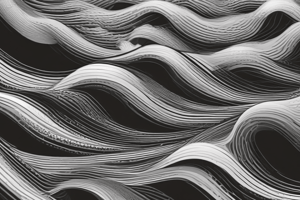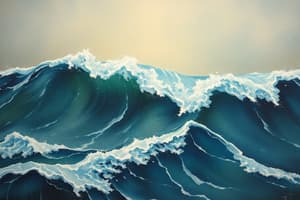Podcast
Questions and Answers
What is the main characteristic of a transverse wave?
What is the main characteristic of a transverse wave?
- The wave can travel through a vacuum.
- The motion of particles is in the same direction as the wave.
- The wave requires a medium to propagate, but the particles don't move.
- The motion of particles is at right angles to the direction of the wave. (correct)
What is the term for the highest point of a transverse wave?
What is the term for the highest point of a transverse wave?
- Trough
- Crest (correct)
- Wavelength
- Amplitude
What is required for a mechanical transverse wave to propagate?
What is required for a mechanical transverse wave to propagate?
- A constant frequency
- A vacuum
- No medium
- A medium with interconnected particles (correct)
What is the distance between two consecutive crests or troughs of a transverse wave?
What is the distance between two consecutive crests or troughs of a transverse wave?
What type of transverse wave is formed when a string is moved up and down?
What type of transverse wave is formed when a string is moved up and down?
What can be inferred about the Earth's outer core based on the behavior of P and S waves?
What can be inferred about the Earth's outer core based on the behavior of P and S waves?
What type of waves are produced by earthquakes that can pass through the outer core of the Earth?
What type of waves are produced by earthquakes that can pass through the outer core of the Earth?
What is characteristic of Rayleigh waves?
What is characteristic of Rayleigh waves?
What is the primary difference between transverse and longitudinal waves?
What is the primary difference between transverse and longitudinal waves?
What type of motion do particles exhibit in a water wave?
What type of motion do particles exhibit in a water wave?
What is common between Rayleigh waves and water waves?
What is common between Rayleigh waves and water waves?
What is required for the formation of longitudinal waves?
What is required for the formation of longitudinal waves?
What type of wave can transmit energy through a vacuum?
What type of wave can transmit energy through a vacuum?
Which type of wave can only move through solids?
Which type of wave can only move through solids?
What can be measured to determine the wavelength of a longitudinal wave?
What can be measured to determine the wavelength of a longitudinal wave?
What is the main direction of particle motion in a transverse wave?
What is the main direction of particle motion in a transverse wave?
What is the purpose of a medium in mechanical transverse waves?
What is the purpose of a medium in mechanical transverse waves?
What is the shape of a transverse wave?
What is the shape of a transverse wave?
What is the source of energy that supports life on Earth?
What is the source of energy that supports life on Earth?
What is an example of a transverse wave in everyday life?
What is an example of a transverse wave in everyday life?
What is the direction of particle movement in a longitudinal wave?
What is the direction of particle movement in a longitudinal wave?
What is the direction of the wave movement in relation to the particle motion in a mechanical transverse wave?
What is the direction of the wave movement in relation to the particle motion in a mechanical transverse wave?
What is the effect of particle vibration on the electric field around a charged particle?
What is the effect of particle vibration on the electric field around a charged particle?
What is the term for the area of high pressure in a longitudinal wave?
What is the term for the area of high pressure in a longitudinal wave?
What is the difference between transverse and longitudinal waves in terms of matter they can move through?
What is the difference between transverse and longitudinal waves in terms of matter they can move through?
What is the reason why S waves cannot pass through the outer core of the Earth?
What is the reason why S waves cannot pass through the outer core of the Earth?
Which of the following waves can be considered as both longitudinal and transverse waves?
Which of the following waves can be considered as both longitudinal and transverse waves?
What is the motion of particles in a Rayleigh wave?
What is the motion of particles in a Rayleigh wave?
What is the characteristic that distinguishes P waves from S waves?
What is the characteristic that distinguishes P waves from S waves?
What is the common characteristic of Rayleigh waves and ocean waves?
What is the common characteristic of Rayleigh waves and ocean waves?
Flashcards are hidden until you start studying
Study Notes
What is a Transverse Wave?
- A transverse wave is a wave where the motion of particles moves at right angles to the direction the wave is moving.
- It resembles a sine or cosine curve.
Characteristics of a Transverse Wave
- The highest point of the wave is called the crest, and the lowest point is called the trough.
- The distance between two crests or two troughs is called the wavelength of the wave.
- Particles move in a transverse direction, meaning that the particle movement is at right angles to the direction of the wave movement.
Examples of Transverse Waves
- Examples include guitar strings, ripples on the surface of water, and electromagnetic waves.
- Electromagnetic waves do not require a medium and can transmit energy through a vacuum.
Transverse Wave vs. Longitudinal Wave
- In transverse waves, particle movement is perpendicular to the wave movement.
- In longitudinal waves, particle movement is parallel to the wave movement.
- Longitudinal waves are formed by the compression of particles, and an example is sound.
Longitudinal Wave Characteristics
- Areas of high pressure are known as compressions, and areas of low pressure are known as rarefactions.
- The wavelength of longitudinal waves can be determined by measuring the distance between two compressions or two rarefactions.
Longitudinal and Transverse Wave Diagrams
- Diagrams show the direction of energy transfer compared to the movement of particles for transverse and longitudinal waves.
- In transverse waves, particles move perpendicular to the energy transfer, while in longitudinal waves, particles move parallel to the energy transfer.
Difference Between Longitudinal and Transverse Waves
- Transverse waves only move through solids, while longitudinal waves can move through solids, liquids, and gases.
- The difference in substances that transverse and longitudinal waves will pass through helped determine that the Earth's core consists of a liquid.
Rayleigh Waves
- Rayleigh waves are a combination of transverse and longitudinal waves.
- They have both a vertical and horizontal component to their direction and are considered surface waves.
- Another example of a wave that is a combination of longitudinal and transverse waves is a surface wave traveling along the surface of water, such as ocean waves.
What is a Transverse Wave?
- A transverse wave is a wave where the motion of particles moves at right angles to the direction the wave is moving.
- It resembles a sine or cosine curve.
Characteristics of a Transverse Wave
- The highest point of the wave is called the crest, and the lowest point is called the trough.
- The distance between two crests or two troughs is called the wavelength of the wave.
- Particles move in a transverse direction, meaning that the particle movement is at right angles to the direction of the wave movement.
Examples of Transverse Waves
- Examples include guitar strings, ripples on the surface of water, and electromagnetic waves.
- Electromagnetic waves do not require a medium and can transmit energy through a vacuum.
Transverse Wave vs. Longitudinal Wave
- In transverse waves, particle movement is perpendicular to the wave movement.
- In longitudinal waves, particle movement is parallel to the wave movement.
- Longitudinal waves are formed by the compression of particles, and an example is sound.
Longitudinal Wave Characteristics
- Areas of high pressure are known as compressions, and areas of low pressure are known as rarefactions.
- The wavelength of longitudinal waves can be determined by measuring the distance between two compressions or two rarefactions.
Longitudinal and Transverse Wave Diagrams
- Diagrams show the direction of energy transfer compared to the movement of particles for transverse and longitudinal waves.
- In transverse waves, particles move perpendicular to the energy transfer, while in longitudinal waves, particles move parallel to the energy transfer.
Difference Between Longitudinal and Transverse Waves
- Transverse waves only move through solids, while longitudinal waves can move through solids, liquids, and gases.
- The difference in substances that transverse and longitudinal waves will pass through helped determine that the Earth's core consists of a liquid.
Rayleigh Waves
- Rayleigh waves are a combination of transverse and longitudinal waves.
- They have both a vertical and horizontal component to their direction and are considered surface waves.
- Another example of a wave that is a combination of longitudinal and transverse waves is a surface wave traveling along the surface of water, such as ocean waves.
Studying That Suits You
Use AI to generate personalized quizzes and flashcards to suit your learning preferences.




